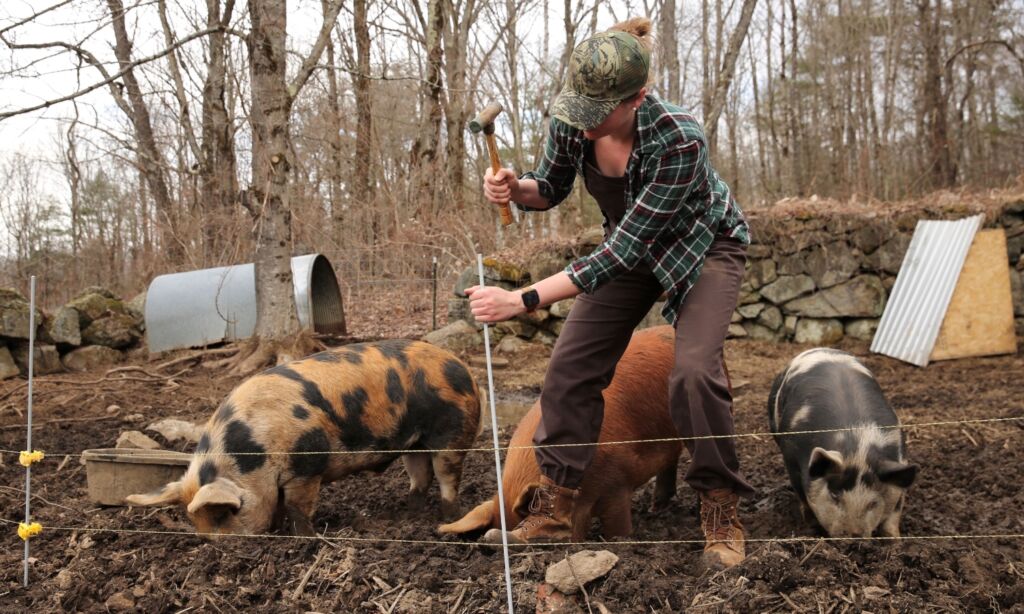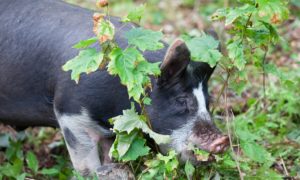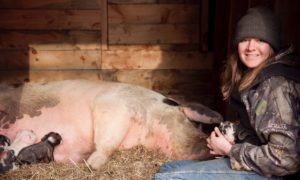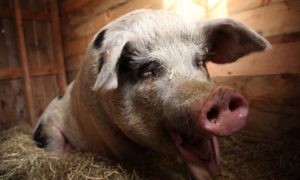If you have any preconceived notions going into this post that pigs cannot be raised solely on electric fence I need you to check yourself at the door. Knock that thinking off right now, because it is not true. We have been raising pigs for a few years now, and guess what? Aside from a permanent perimeter fence (with an electric training line inside) off our farrowing house, our pigs are raised exclusively on electric fence. Yep, from one strand of polywire to electric netting, we use it all. It is 100% possible with the right training and equipment. I am going to show you how we train piglets on electric fence to set ourselves up for success.
The key to successfully containing a 100, 400, or even 900 pound pig on electric is to train them properly when they’re 10-30 pounds. Our piglets are technically exposed to a single hot line of polywire from day one, as it runs inside the permanent perimeter fence we have in our farrowing area. They aren’t exactly out exploring the world at that age, so they aren’t necessarily touching it, but it’s there. Once they are around a week old and they start to explore their outdoor surroundings, I will occasionally hear a piglet screech that touched the fence. At this point they are getting shocked and can feel it a bit, but they aren’t really grasping the concept of what it is and to stay away from it. This is why a permanent fence that surrounds is important, they need a physical barrier to stop them from running through.
Following our general timeline of raising piglets, it is around the two week mark that we open up a new section adjacent to the permanent area with our Premier One Electric Netting. Why don’t we expose them earlier? We have found that any younger than two weeks old the piglets are too small, meaning they don’t physically have enough weight to properly ground themselves to complete the circuit. The more an animal weighs, the more its feet/hooves are firmly planted into the ground, which will ground that particular animal more, allowing a stronger shock from the fence. Prior to that two week-ish time frame they are still small enough they could squeeze through the squares in the nets. At that size they will feel a significantly reduced shocked (if any), which could allow them to push their way through the holes in the netting unscathed. This will teach them that the fence is not something that causes a brief pain or discomfort, and doesn’t need to be respected. Then you’re really setting yourself up for failure.
We keep the netting up from the two week point until a couple weeks after the piglets are weaned. Anywhere from 8-10 weeks depending on how they’re growing. We raise our feeders and breeding stock in the woods, and it’s at this point they graduate from the netting and are contained by 3 strands of polywire. It allows us to set up a bigger area for them, and it doesn’t get grounded out like the netting can when they’re tossing leaves, branches, etc on it. Believe me, if we raised our pigs on more level ground that wasn’t in the woods, we would use the netting to rotate them just like we do with our sheep and goats. It’s incredibly easy to move, set up, and tear down. But, given the terrain it just isn’t ideal and would cause us more issues than a three strand set up. So, once they are at the graduation age/size to move from netting to single strands, we test the piglets and their respect for the fence.
In the area that is contained by netting, we will run a single line of polywire a couple inches off the ground (snout height) to section off a corner. Then, we observe and wait for any squeals. Some pigs won’t test it at all because they know what it is. Others, may take a few shocks for the message to really settle in, which is why the netting is still set up in case they slip by it. Once we can see the piglets are respecting it after a few days, we usually repeat the test one more time in a different corner just to make extra sure they identify what it is and know not to try and go past it. This may seem like overkill to some, but I am NOT chasing escaped piglets. It’s at this point we are sure they respect it that we start moving them through our woods contained by our three strand set up without any perimeter fence.
Fencing Tips
I have heard of many a failed attempts at raising pigs exclusively on electric. Occasionally you do get a pig that is just a genuine a-hole and will try to break through anything. But most of the time, it can be traced back to improper set up, a glitch in the fence, or human error. This post I wrote a while back goes over some of the tools we use in our set up and how we use them.
I cannot overemphasize enough the importance of a HOT fence and a STRONG ground. You should not even attempt to train piglets on electric fence until you know that you have achieved both. We use a plug in 50 mile Parmak charger with a digital output. Because we run travel lines from this charger along different fences, the digital output is irreplaceable. There is never any question if there is a branch down on a fence somewhere, or some kind of issue because I will be able to see a voltage drop. Even with multiple nets from the other animals connected to it as well as the pigs single strands, it can still click away at 14,000 volts. We have a strong ground and that baby packs a punch. This is a big part of why our animals don’t escape.
If you can’t do some kind of plug in fence, I personally am not a fan of solar chargers. I feel they don’t have a strong enough charge and any animal is liable to just walk right through the fence. This couldn’t be more true with pigs. Some people use them with great success and argue with me on this, but I have also tried them (attached to my existing grounding rods that with my Parmak fencer you feel like you got struck by lightening) and I could barely feel anything when I grabbed the fence. If you’re in a setting where you must be mobile and move the fencer along with the netting (we could never move grounding rods like that with our landscape) I would recommend using a set up with deep cell marine battery. The batteries can really last, and if you have two, you can just swap them out for each other so you always have one charged on standby. I personally would rather be occasionally swapping out batteries than chasing escaped pigs.

There are many ways to train piglets on electric fence I’m sure, but this is the way we have done it for the past several years. Knock on wood, despite the varying sizes of pigs that we have kept and use of netting/ different numbers of strands, escaping hasn’t been an issue. Red Jamie did escape twice this winter, but it’s because the snow was so high she was able to walk right over the fence. They can’t respect what they don’t see! I largely attribute our success to properly training them while they’re young, while also giving them plenty of space so they don’t want to leave it.
Happy Fencing,

**Some of the links on this site are affiliate links. I only link to products I have used, abused, and believe in. While I do not make commissions on these, they do allow my partners to track business I have generated for them. I wholeheartedly appreciate you using my affiliate links for any of the products I recommend you may purchase! It keeps the educational and informative content coming.




